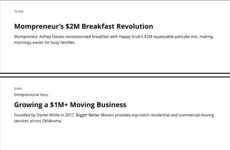
Tisah Tucknott — August 1, 2009 — Business
References: creativeclass
Richard Florida is one of the brightest men out there, as he is not only a best selling author and professor, but is also the founder of Creative Class Group, a company that creates new trends in business and the community.
Having written for for the Globe and Mail, the New York Times and the Wall Street Journal, it comes as no surprise that Richard Florida’s book “Who’s Your City?” has been getting rave reviews and is both a National Best-Seller and an International Best-Seller.
10 Questions With Richard Florida
1. How did you get involved in writing and what motivates you to continue?
From an early age to my time as an undergraduate at Rutgers (and later graduate school at Columbia), I have always loved reading and writing. I would spend hours at the library consuming books and readings. I have always enjoyed independent study; I find exploring a research question and identifying potential solutions and answers to be a fulfilling endeavour.
What motivates me? I think we are a cross roads in economic development and the global economy. Future economic growth will be driven by creativity and innovation; so if we want to increase it, we have to tap into the creativity and innovative spirit of everyone. That’s what makes me optimistic. For the first time in human history, the basic logic of our economy dictates that further economic development requires the further development and use of human creative and innovative capabilities. The great challenge of our time is to find ways to tap into every human’s creativity.
2. How significant are the topics of cool hunting and trend spotting in the world of business writing?
A critical element of my research is to identify patterns which define trends. To capitalize on those opportunities and challenges, it’s important for businesses, organizations, and communities to understand the broader global picture and where the economy and market is headed in the future.
3. How do you define a trend?
A trend is a direction in which popular culture, society and the economy are moving a given time; we look to trends to provide parameters for defining and identifying patterns of behaviour.
5. How do you define cool?
I don’t.
6. Do you need a culture of innovation to create something that is cool?
A culture of diversity and tolerance creates a creative environment which can ignite and foster innovative and entrepreneurial ideas. Economic prosperity relies on cultural, entrepreneurial, civic, scientific, and artistic creativity.
Creative workers with these talents need an environment that is open to new ideas and different people. Organizations, businesses and laces receptive to immigration, alternative lifestyles, and new views on social status and power structures will benefit significantly in the creative age.
7. What is the best way to create an infectious idea, product or service?
The product has to be authentic, creative and smart.
8. What is the key to innovation?
Jane Jacobs, one of the leading public intellectuals of the 20th century, captures my sentiments about this question when she said, “Old ideas can sometimes use new buildings. New ideas require old buildings.” I think innovation is depends on an environment that is authentic and steeped in a sense of history.
Innovation also needs an open and diverse environment, where ideas can follow openly without a fear of judgment or ridicule. A diversity of backgrounds helps to strengthen the creative process and spur creativity and generate high-tech growth.
9. Professionally, what do you want to be doing or studying in 10 years?
I am a huge music fan. I would love to write a book about music as the “canary in the coalmine” to gauge a region and community’s technology innovation and creativity.
10. What are your most important hobbies?
Playing guitar, reading, cycling and speaking to communities and organizations around the world about creativity and economic prosperity.
11. How do you reset yourself to become creative?
Cycling. I am avid cyclist; cycling is the best way to recharge myself.
Having written for for the Globe and Mail, the New York Times and the Wall Street Journal, it comes as no surprise that Richard Florida’s book “Who’s Your City?” has been getting rave reviews and is both a National Best-Seller and an International Best-Seller.
10 Questions With Richard Florida
1. How did you get involved in writing and what motivates you to continue?
From an early age to my time as an undergraduate at Rutgers (and later graduate school at Columbia), I have always loved reading and writing. I would spend hours at the library consuming books and readings. I have always enjoyed independent study; I find exploring a research question and identifying potential solutions and answers to be a fulfilling endeavour.
What motivates me? I think we are a cross roads in economic development and the global economy. Future economic growth will be driven by creativity and innovation; so if we want to increase it, we have to tap into the creativity and innovative spirit of everyone. That’s what makes me optimistic. For the first time in human history, the basic logic of our economy dictates that further economic development requires the further development and use of human creative and innovative capabilities. The great challenge of our time is to find ways to tap into every human’s creativity.
2. How significant are the topics of cool hunting and trend spotting in the world of business writing?
A critical element of my research is to identify patterns which define trends. To capitalize on those opportunities and challenges, it’s important for businesses, organizations, and communities to understand the broader global picture and where the economy and market is headed in the future.
3. How do you define a trend?
A trend is a direction in which popular culture, society and the economy are moving a given time; we look to trends to provide parameters for defining and identifying patterns of behaviour.
5. How do you define cool?
I don’t.
6. Do you need a culture of innovation to create something that is cool?
A culture of diversity and tolerance creates a creative environment which can ignite and foster innovative and entrepreneurial ideas. Economic prosperity relies on cultural, entrepreneurial, civic, scientific, and artistic creativity.
Creative workers with these talents need an environment that is open to new ideas and different people. Organizations, businesses and laces receptive to immigration, alternative lifestyles, and new views on social status and power structures will benefit significantly in the creative age.
7. What is the best way to create an infectious idea, product or service?
The product has to be authentic, creative and smart.
8. What is the key to innovation?
Jane Jacobs, one of the leading public intellectuals of the 20th century, captures my sentiments about this question when she said, “Old ideas can sometimes use new buildings. New ideas require old buildings.” I think innovation is depends on an environment that is authentic and steeped in a sense of history.
Innovation also needs an open and diverse environment, where ideas can follow openly without a fear of judgment or ridicule. A diversity of backgrounds helps to strengthen the creative process and spur creativity and generate high-tech growth.
9. Professionally, what do you want to be doing or studying in 10 years?
I am a huge music fan. I would love to write a book about music as the “canary in the coalmine” to gauge a region and community’s technology innovation and creativity.
10. What are your most important hobbies?
Playing guitar, reading, cycling and speaking to communities and organizations around the world about creativity and economic prosperity.
11. How do you reset yourself to become creative?
Cycling. I am avid cyclist; cycling is the best way to recharge myself.
Trend Themes
1. Importance of Creativity and Innovation in Economic Growth - There is a growing need to tap into the creativity and innovation of every human in order to drive future economic growth.
2. Identifying Patterns and Trends in Business - Identifying patterns in popular culture, society, and the economy can provide parameters for defining and identifying patterns of behavior.
3. The Role of Culture and Diversity in Creativity and Innovation - A culture of diversity and tolerance creates a creative environment which can ignite and foster innovative and entrepreneurial ideas.
Industry Implications
1. Business Consulting Services - Business consulting firms can help businesses and organizations understand the broader global picture and identify future economic opportunities and challenges.
2. Publishing Industry - The publishing industry can produce books and content on creativity, innovation, and trends in business to help organizations stay up-to-date and competitive.
3. Creative Industries - Creative industries, such as music, can provide insight into technology innovation and creativity, and potentially spark new disruptive innovations.
4.6
Score
Popularity
Activity
Freshness























